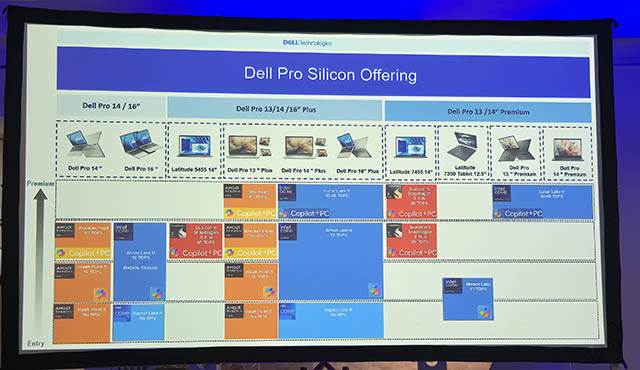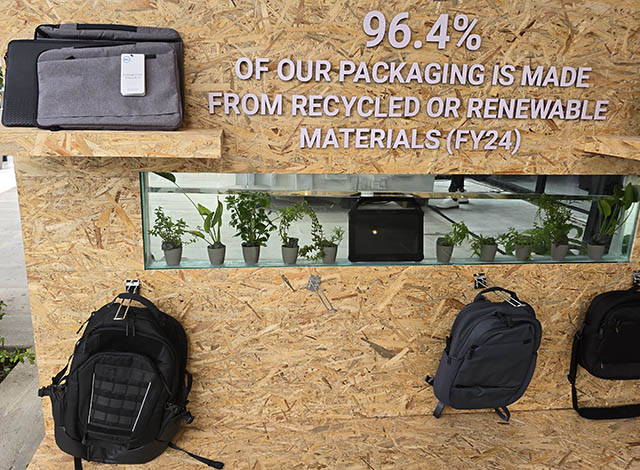How Dell is aiming to ready users for the AI era
By Ryan Noik 2 April 2025 | Categories: feature articles
For as long as I can remember, Dell notebooks carried the moniker of Latitude, Inspiron, Precision and XPS. That changed this year, and recently, the company held an event to explain the rationale – and the new names for its newest AI PC portfolio.
Dell Technologies has been on somewhat of an education and charm offensive over the past few months to introduce and explain its new branding and PC line, and how it fits into a broader vision.
Admittedly, upon release of the news I didn’t understand why the company would do such a thing, nor how the new ranges distinguished themselves from the old ones.
However, the event went to great lengths to clarify that the move is intended to make it easier than ever for users to find the right device for their needs.
While it has attempted to simplify this process, it also has a fair amount of depth, with the three product categories each having three tiers. Each are intended to more clearly focus on meeting the core needs of each customer.
If looking for a new Dell notebook, customer can now choose between a Dell (designed for play, school and work), Dell Pro (designed for professional-grade productivity) and Dell Pro Max (designed for maximum performance).
Within each of these categories are three tiers. The Base tier offers the essentials of its category, the Plus tier offers more features, and then the Premium tier, which introduces more premium materials and other advances for the mobile worker.
“We’ve made it easy to distinguish products within each of the new product categories, and our consistent approach to tiering lets customers pinpoint the exact device for their specific needs. Above and beyond the starting point, there’s a Plus tier that offers the most scalable performance and a Premium tier that delivers the ultimate in mobility and design,” elaborated Doug Woolley, General Manager and Vice President, Dell Technologies South Africa.

Designed to last
Where the Dell Pro Premium range stands out is that these devices have a modular USB-C and consist of five types of recycled and renewable materials. They also are equipped with batteries made with 80% less cobalt or with 50% recycled cobalt batteries, and thus are literally designed to be more environmentally friendly.
This push for environmentally friendly products has been a constant over more than a decade now, to the extent that even the laptop bags are made in part from recycled material, and 94% of packaging that the notebook comes in is similarly made from recycled or renewable material.
While we cannot get away from needing to use PCs in our daily lives, it is heartening to see that at least it can be done in a more environmentally friendly manner.
The new range includes four new Copilot+ devices from the Plus tier, which, the company enthused, introduces Dell’s most scalable Dell PCs with a balance between versatility and productivity. The devices, which also boast a brand-new design, are powered by Intel Core Ultra (Series 2, V SKUs).
One area where the company appears to have standardised is on size. Devices are now largely either 13’, 14’’ or larger 16’’ (I still hold that the Dell XPS’s 17’’ screen in a 15.6’’ chassis is the best design decision I have seen, but at least 16’’ is a good amount of screen real estate).
The company has also included 2-in-1 options in the new range, with a Dell 14 Plus & Dell 14 Plus 2-in-1. Both are intended as portable devices that offer flexibility to those who blend their creative and everyday needs.
There are also larger 2-in-1’s - Dell 16 Plus and Dell 16 Plus 2-in-1, with these devices allowing for both traditional and creative workflows. A 14 inch and a 16-inch tablet option for drawing on sounds like it would be of particular appeal to digital artists, as well as to those who like consuming content on larger screens, but we will have to see how that works in real life.

Evolving the old rather than discarding it
What quickly became clear is that we haven’t actually lost anything. The XPS and Latitude capabilities are there in spirit, as are what the Inspiron and high end Precision offered.
The Dell range, whether Base, Dell Plus or Dell Premium, correlates to the older Inspiron, XPS and Vostro range.
The Dell Pro, whether the base, Dell Pro Plus or Dell Pro Premium, is the equivalent of the older Latitude and Optiplex, while Dell Pro Max is the equivalent of the Precision notebooks.
By going with this new naming convention and the new lineup, it seems like the company is aiming to offer users a way to even more finely distinguish the best device for their needs, without having to pay for something that might be more than what they actually require.
Once I became accustomed to the new naming conventions – and saw that we aren’t losing much, if anything by way of functionality, I believe the new convention is a particularly smart move. Given the volatility of global markets, and how astronomically priced rival Apple MacBooks have become – and more than likely, will only become more expensive, it makes sense to offer users a way to enter the AI era with the most suitable device at a pricepoint that best suits them.
AI, everywhere
Not only do we still need PCs, but Dell’s shift to this new lineup seems to be flowing with a current major trend in the world, towards an AI infused era.
The company explained that its new PCs moving forward are now AI PCs, boasting a dedicated processing unit that just deals with AI workloads, while the CPU and GPU handle general tasks and graphics intensive tasks respectively.
The immediate benefit of this will be on battery life, the company explained. When the majority of a workload doesn’t have to tax the CPU but instead can be handled by its own dedicated processor, this will mean that the machine doesn’t have to work as hard – and draw more battery power -when away from one’s desk. The result is longer battery life, a boon, particularly for those of us who use their notebooks while travelling.
Based on a very brief and initial hands on with a few devices, the quality of build that we have become accustomed to is still very much there. The devices look sleek, sophisticated and attractive. They feel well made, and, always most important, are backed by solid after sales support.
Final analysis
The question is, whether having an AI PC is something we all need right now, or whether we can still squeeze use from our existing notebook, or whether we would be best served of acting quickly and taking the leap into an AI ready PC right away. That remains to be seen.
Most Read Articles

Have Your Say
What new tech or developments are you most anticipating this year?



